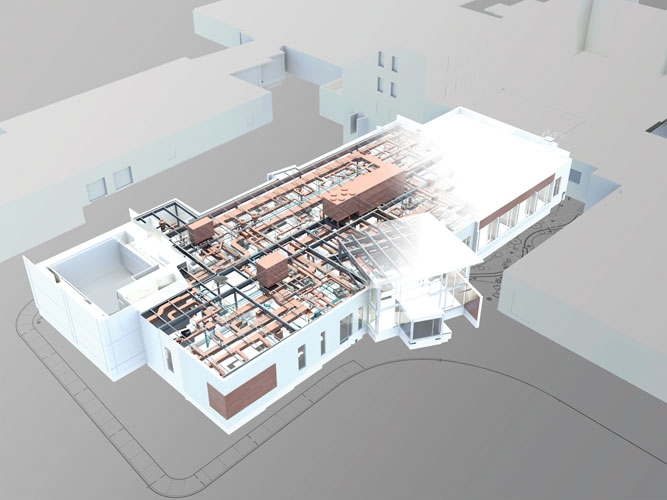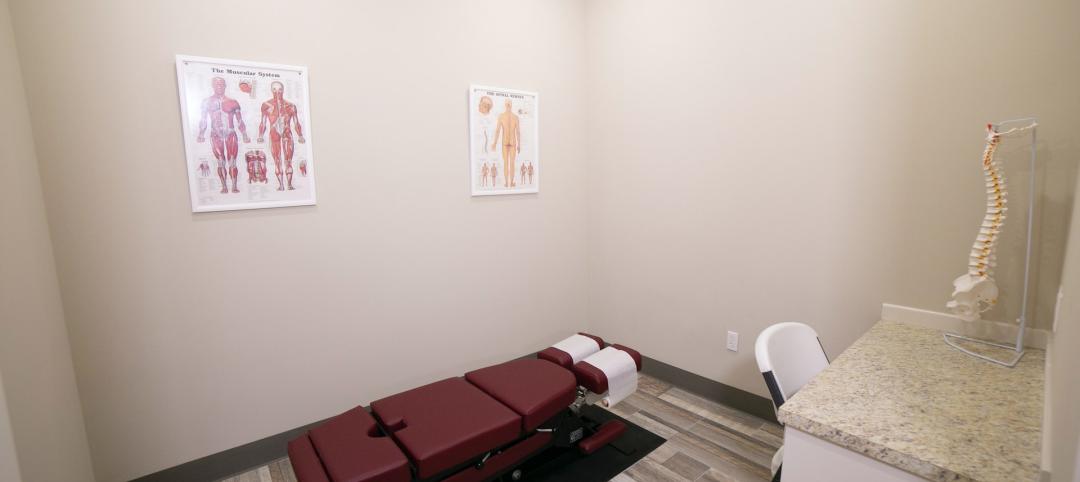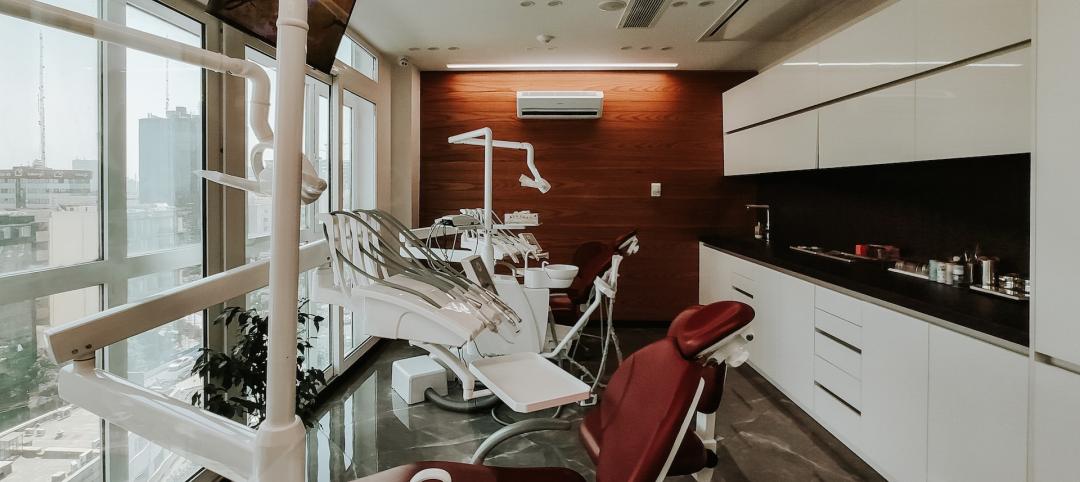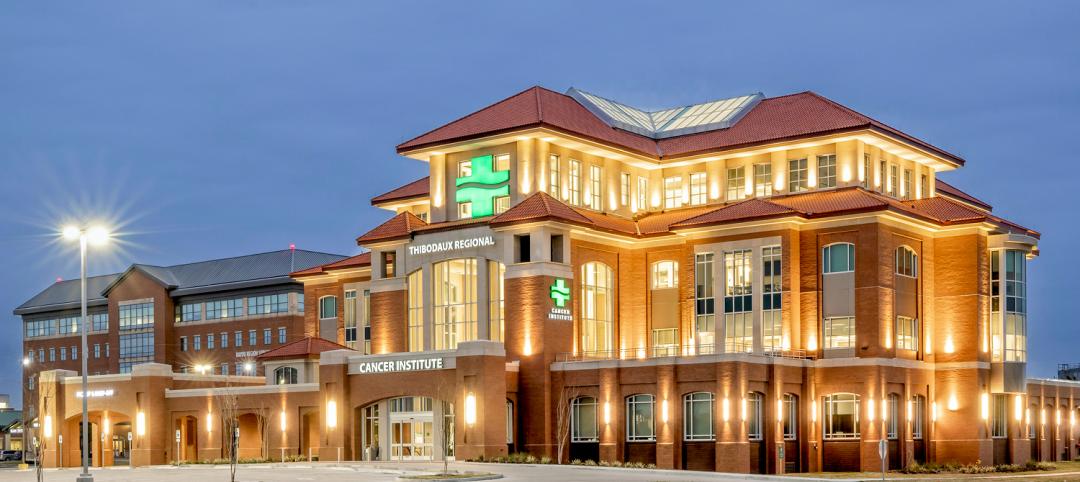Everyone talks about the need to bring together building information modeling, virtual design and construction, and integrated project delivery in the design and construction of complex projects. This is especially true in the healthcare realm, but so far there have been few cases of true integration, where Building Team members are bound by a written, performance- and incentive-based IPD agreement and where BIM/VDC is a crucial factor in fulfilling the IPD.
It is therefore refreshing to report how a healthcare system and its Building Team united to create a sterling example of BIM/VDC-based IPD. The case in point is the Marlborough (Mass.) Hospital Cancer Pavilion, a new 14,000-sf, $12.7 million cancer treatment center nearing completion on the site of the existing hospital, 30 miles west of Boston. The project is the first using such an agreement between the University of Massachusetts Memorial Medical Center; Tocci Building Cos. (CM), Woburn, Mass.; The S/L/A/M Collaborative (architect), Glastonbury, Conn.; and their key trade subcontractors and consultants.
The new wing will have a linear accelerator for radiation oncology, a CT simulator for diagnostic imaging, and outpatient medical oncology services to create a unified treatment experience for cancer patients. The nearest linac facilities are at Massachusetts General Hospital, 30 miles away in Boston, and in Middlesex, Conn., more than 90 miles away.
Owner UMass Medical wanted to get the new oncology center open to the public as quickly as possible, to lock in the suburban Boston market for this treatment technology. The availability of local radiation oncology services is particularly appealing because many cancer patients require radiation five days a week for four to eight weeks in a row.
Project Summary
Marlborough Hospital Cancer Pavilion
Marlborough, Mass.
Building Team
Owner: University of Massachusetts
Memorial Medical Center
Architect: The S/L/A/M Collaborative
Interior design: Delorey Contract Interiors
Consulting engineer: Fitzemeyer & Tocci Associates
Fire protection: Covenant Fire Protection
Geoenvironmental engineer: GZA GeoEnvironmental
Mechanical/plumbing contractor: Youngblood Co.
Electrical contractor: Senecal Electric
HVAC contractor: Renaud HVAC & Controls
Metals contractor: Tims Fabricators
Construction manager: Tocci Building Cos.
Meeting client needs via VDC
Both the S/L/A/M Collaborative and Tocci are well-established 3D parametric BIM practitioners. S/L/A/M has delivered 40 BIM projects to date and was the first architect to fully document and deliver a project using BIM for the State University of New York system. Tocci is an industry pioneer and leader in virtual design and construction; the company uses BIM on every project. The Marlborough hospital project was Tocci’s second IPD job, having delivered the LEED Platinum Autodesk AEC Headquarters in Waltham, Mass., in 2008 (see www.BDCnetwork.com/Autodesk/AEC/HQ.)
UMass Medical, Tocci, S/L/A/M, and several key subcontractors entered into a modified version of construction lawyer Howard Ashcraft’s three-party agreement. The IPD united them in an incentive-focused, project-based entity where profits could only be unlocked if the team achieved specific project goals. (See http://www.BDCnetwork.com/Ashcraft.)
Early in the collaboration, Tocci, S/L/A/M, and UMass Medical created a project manual that defined how the team would approach the agreed-upon objectives. The manual covered communication methods, project execution, and BIM execution, with the overarching goal of leveraging the BIM model toward a more efficient design and delivery process. The parties decided to share a federated Revit model that would be used by all participants over a website. Co-location was performed at S/L/A/M’s Connecticut office at the design stage and progressed to the job site during construction.

The linear accelerator, which represented about half the total cost of the Marlborough Hospital Cancer Pavilion, required a containment vault formed from rebar and nearly 500 cubic yards of concrete. BIM/VDC were instrumental in planning penetrations for services to eliminate the need for any vault coring.
The design team responded to requests from Marlborough Hospital that the Pavilion embrace the “healing environments” ideal. The finishes are very spa-like. S/L/A/M specified soft-colored, open environments with large amounts of millwork and straight, narrow hallways on a grid pattern.
“There was a significant collaborative effort that contributed to target-value design and maintaining the budget,” says Laura Handler, Director of VDC at Tocci. “Some of that happened in a substantial part of the design phase, but also in delivering exactly what the hospital needed. Had the owner not been involved, it would have been much harder to bring the project closer to feasibility.”
Even with an expert core BIM team, the project was still at a scale where not all subcontractors were equally BIM-savvy. Fire protection engineer Covenant Fire Protection and mechanical/plumbing subcontractor Youngblood Company had experience modeling in Revit, so they were able to perform their own modeling scope. However, Senecal Electric and Renaud HVAC & Controls, the other two IPD partners, had virtually no previous BIM experience.
“One of the facets of our agreement was that whoever was most capable to perform the scope of a job should perform it,” says Tocci’s Assistant Project Manager, Jeremy Garczynski. Thus, Tocci modeled the VDC portions of the contractor’s scope with input from other members of the Building Team. For the HVAC systems, Renaud took the lead, with Project Manager Jay O’Neil reviewing the Tocci Revit model twice a week to ensure it performed as specified. “It was field experience working alongside 3D modeling experience,” says Garczynski.
With narrow hallways and not a great deal of ceiling space, fitting in the HVAC and electrical and plumbing systems was a design conundrum requiring careful sequencing. The new Cancer Pavilion is connected to the existing hospital by a CMU shear wall, through which any services from the existing building to the new wing had to pass. However, the CMU contained grouted cells and bond beams that were impermeable, leaving minimal space for 12 individual services to pass through.
The key trades met over a 12-week period to untangle the problem of the limited space above the ceiling. From these meetings, the mechanical/electrical team decided to combine the services to reduce the number of penetrations to four. Through weekly model uploads and online meetings, the MEP and fire-protection teams figured out where to install the services. By the time Tocci signed off on the final sequencing plan, all the trades knew the order in which they were to finish their work, and understood what the other trades would be doing on site at the same time.

Light, spa-inspired colors and finishes convey a feeling of serenity in the Cancer Pavilion. An extensive use of millwork helps make the treatment spaces more homelike and less institutional.
“In a lot of cases, it’s better to have subcontractors speaking directly to the architect and not through us,” says Garczynski. “For the ceiling space, we needed an intense, intimate coordination process. The roof drains weave around ductwork in the corridors. The exact layout pattern in the model was in the coordination drawings. They matched in-field conditions. It sounds like a small victory but it saved time and frustration.” Garczynski credits Youngblood, the mechanical/plumbing contractor, with making it work: “Their capability with Revit and the coordination aspect of this really played well together.”
Getting the accelerator into position
Installing the linear accelerator presented its own problems. The unit specified by Marlborough Hospital—TrueBeam radiation therapy and radiosurgery—is an integrated system that coordinates imaging, patient positioning, motion management, and treatment to administer extremely precise radiation dosages. The technology gives physicians the ability to tackle complex treatments, including radiosurgery and tumor removal, with greater patient safety and comfort. The linear accelerator accounted for nearly half the cost of the whole project.
“With a linear accelerator, the vault is critical to ensure that radiation doesn’t escape the room,” says Handler, a member of the 2010 class of BD+C’s “40 under 40.” “We did a lot of detailed modeling to confirm that all requirements were being met, and also detailed drawings for penetrations into the vault for execution. Any penetration had to meet very specific criteria.”
After the vault was formed in rebar, Tocci had 50 mixing trucks ready to place almost 500 cubic yards of concrete. The layout of equipment and accessories was vetted again and again to ensure that no coring would have to take place through the four-foot-thick walls or through the rebar.
“It’s a huge piece of equipment,” says Garczynski. Due to code requirements, the facility housing the linac had to be virtually 100% completed and inspected before the linac could be installed. Garcynski and other members of the Tocci team worked with S/L/A/M to create a sequencing diagram for the riggers to move the linear accelerator into the finished space. It was successfully placed on its moorings last month.
“On this project, the IPD helped us make decisions much more quickly by having all of the stakeholders in the room,” says David Neal, Principal-in-Charge for The S/L/A/M Collaborative.
The IPD process also helped the team clear numerous regulatory hurdles in the documentation and notification for commissioning with state and local agencies. While the project did go through some funding starts and stops, it is on schedule to open this spring after breaking ground a year ago.
There is an incentive-compensation component in the IPD agreement. With the project nearing completion, the Building Team is on target to unlock that shared profit.

An entranceway reminiscent of a lantern welcomes patients to the Cancer Pavilion, echoing the “beacon of hope” theme UMass Medical uses in its marketing. The new imaging and treatment facility serves patients who previously could not receive cancer therapy closer than a 30- to 45-minute drive.
Related Stories
Sponsored | Resiliency | Dec 14, 2022
Flood protection: What building owners need to know to protect their properties
This course from Walter P Moore examines numerous flood protection approaches and building owner needs before delving into the flood protection process. Determining the flood resilience of a property can provide a good understanding of risk associated costs.
Healthcare Facilities | Dec 14, 2022
In Flint, Mich., a new health center brings together children’s mental and physical health services
Families with children who experience behavioral health issues often have to travel to multiple care facilities to see multiple teams of specialists. In Flint, Mich., the new Center for Children’s Integrated Services at Genesee Health System (GHS), a public mental health provider, brings together all of the GHS children’s programs, including its behavioral health programs, under one roof. It provides families a single destination for their children’s mental healthcare.
Adaptive Reuse | Dec 9, 2022
What's old is new: Why you should consider adaptive reuse
While new construction allows for incredible levels of customization, there’s no denying that new buildings can have adverse impacts on the climate, budgets, schedules and even the cultural and historic fabrics of communities.
Healthcare Facilities | Nov 17, 2022
Repetitive, hotel-like design gives wings to rehab hospital chain’s rapid growth
The prototype design for Everest Rehabilitation Hospitals had to be universal enough so it could be replicated to accommodate Everest’s expansion strategy.
Seismic Design | Nov 16, 2022
SPC-4D: 7 reasons California hospital building owners should act now to meet seismic compliance
Seismic compliance with the applicable California building codes is onerous and disruptive for building owners, especially for a building in the heavily regulated sector of healthcare. Owners of older buildings that house acute care services have a big deadline on the horizon—Jan. 1, 2030, the cutoff date to upgrade their buildings to SPC-4D.
BAS and Security | Oct 19, 2022
The biggest cybersecurity threats in commercial real estate, and how to mitigate them
Coleman Wolf, Senior Security Systems Consultant with global engineering firm ESD, outlines the top-three cybersecurity threats to commercial and institutional building owners and property managers, and offers advice on how to deter and defend against hackers.
Giants 400 | Oct 6, 2022
Top 60 Medical Office Building Contractors + CM Firms for 2022
PCL Construction, Adolfson & Peterson, Swinerton, and Skanska USA top the ranking of the nation's largest medical office building (MOB) contractors and construction management (CM) firms for 2022, as reported in Building Design+Construction's 2022 Giants 400 Report.
Giants 400 | Oct 6, 2022
Top 50 Medical Office Building Engineering + EA Firms for 2022
Jacobs, Gresham Smith, KPFF Consulting Engineers, and IMEG Corp. head the ranking of the nation's largest medical office building (MOB) engineering and engineering/architecture (EA) firms for 2022, as reported in Building Design+Construction's 2022 Giants 400 Report.
Giants 400 | Oct 6, 2022
Top 100 Medical Office Building Architecture + AE Firms for 2022
CannonDesign, Perkins Eastman, HGA, and E4H Environments for Health Architecture top the ranking of the nation's largest medical office building (MOB) architecture and architecture/engineering (AE) firms for 2022, as reported in Building Design+Construction's 2022 Giants 400 Report.
Giants 400 | Oct 6, 2022
Top 60 Outpatient Facility Contractors + CM Firms for 2022
Whiting-Turner Contracting Co., PCL Construction, Skanska USA, and Power Construction top the ranking of the nation's largest outpatient facility contractors and construction management (CM) firms for 2022, as reported in Building Design+Construction's 2022 Giants 400 Report.
















